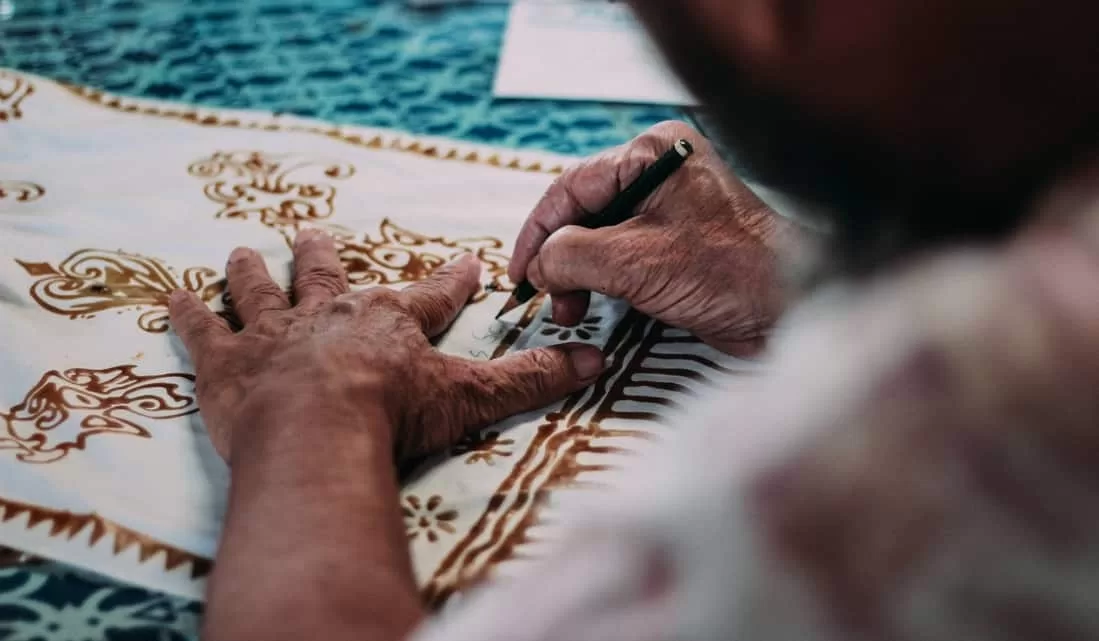After the Dior’s Mumbai show, it’s time to ask why artisans still don’t get a platform to voice their needs
Now that all the memes and look-who-I-met selfies at the recent Dior show in Mumbai have stopped cluttering social media feeds, let’s look at that one person without whom this “historic moment” wouldn’t have been possible: the karigar.
From the moment an Indian model opened the luxury brand’s fall 2023 col-lection showcase on 30 March, walking the cobbled path of Gateway of India in a black silk lungi dress and matching chappals, it was clear what Dior was going to serve: The work of the Indian craftsperson, who spends 8-10 hours a day for months with his fingers dancing between threads, beads and stones, to help create one outfit that may dazzle the world.
While the 99 looks of the artistic director of Dior women’s wear, Maria Grazia Chiuri,didn’t offer anything extraordinary in terms of style or silhou-ettes, flirting with clichés (Madras checks, toile de Jouy showing tigers and elephants), they made a strong point in celebrating Indian craftsmanship and yet again turning the international spotlight on the karigar, the artisan. It is a big deal, even if some critics say the hoo-ha around the event was a massive marketing strategy, even cultural colonialism. No other major Western brand has ever included India in one of its seasonal calendars. No other brand has acknowledged the contribution of karigars so loudly. It’s an open secret that luxury houses like Hermès and Chanel have been sourcing embroidery from India for decades. (Hermès carries the ‘Made In India’ tag when their clothes and accessories are made in India.)
Also read: Will the Dior Mumbai show prove to be a turning point for the karigar?
“It’s time we talked more openly about the hands behind the creations, the hands behind fashion,” Chiuri had said at a press conference at Mumbai’s Taj Mahal Colaba a day before the show. “People need to know who are the hands behind the creations.”
People also need to see their faces and, more importantly, hear their voices. For far too long, the karigar has remained faceless and voiceless. It’s time we became aware of their wants, needs and demands, hearing directly from them. It’s time they spoke about why they continue to be in a profession that pays little but results in clothes that sell for lakhs globally.
Can we, whether it’s an Indian or international brand, give them a platform to express themselves so freely?
“I have said this several times earlier— the era of others representing the voices of karigars is over,” says textile curator Mayank Mansingh Kaul. “It is the responsibility of the media to find ways to ask such questions to them directly, given that social media, the internet and fast phone connectivity have enabled such access in recent years. It becomes equally necessary for self-appointed arbitrators to step down from speaking on their behalf. But enabling voices can also be often meaningless without giving them faces.”
It is also time for more brands to clearly mention on their labels that the embroidery and the craft is from India and acknowledge the role of the individual behind the art.
Reema Kapoor, who has been a training consultant with the Ahmedabad-based Self-Employed Women’s Association (Sewa) for 25 years, concurs: “Depending on the kind of work, people are earning around ₹400 a week. There are women who get ₹4 per shirt for removing extra threads from it. Can you imagine the kind of stress such work puts on the eyes? All for ₹4. We need more unions, more collectives made for artisans by artisans.”
KNOWING THE MAKERS
Fashion is an industry that offers a livelihood to millions of people across the world. If you go by the figures from the India Brand Equity Foundation, a trust created by the Union commerce ministry, India is among the world’s biggest garment exporters, taking care of a textiles market worth about $250 billion (around ₹20.5 trillion). Add the exceptional craftsmanship of the 40-million plus karigars and it’s easy to understand why luxury brands have outsourced a large chunk of their embroidery work to India.
Mumbai-based Sharafat Sayyed, 36, is one of them. His brothers, father and fore-fathers have always done hand embroidery. “That’s the only work I know. And it’s clean; I don’t have to run around. We just sit and work,” Sayyed, who has been working since 2008, tells me in Hindi. He’s one of the 100-plus workers at 2M Ateliers, which creates garments and accessories for the world’s leading luxury houses. He gets ₹25,000 per month for working eight hours six days a week. “There’s pride in my work. How many people know this art? I am one of the lucky few to come from such a background. What I am most proud of is that I am helping create something that is being worn internationally. The ‘Made in India’ tag is going global in a way because of me. How many people can say that?”
When asked what else he would want, he says: “More money and fame. The recognition will help me move forward, do better.”
I get a similar response from Afzal Saidullah Shaikh, 67, who has been a karigar for over four decades. He’s currently working for designer Rahul Mishra from his home in Kolkata’s Hooghly district. “The work is hard. You have to sit the whole day and look at threads and beads so closely. You develop back problem, eye problem…,” says Shaikh who, too, wants to be famous, to be known for his craft. “There’s a lot of poaching. Often designers come and ask me to work for them despite knowing that I work with Rahulji.”
Even more important than name and fame, though, is security of work, livelihood and earnings for the karigars. “This would mean giving them regular pay, health insurance and all required benefits, something that many people (designers or contractors) don’t do as much,” says Mishra, who employs 300 artisans directly and over 1,000 artisans indirectly across the country. “It’s a little difficult to give face to 1,000 artisans who have worked on a garment but it’s definitely possible to give them fair pay.”
Collaborations like the Dior one (Mumbai’s Chanakya atelier and school of craft has been working closely with Chiuri for close to two decades; the fall collection included works by their artisans), Mishra says, remind the world that “fashion designing is a community exercise and you can’t move forward till everyone moves along with each other”.
The Dior show is also a wake-up call for Indian designers to speak about the artisans, believes Maximiliano Modesti, founder of 2M atelier. “It starts from home. Until your homegrown brands give credit to karigars and listen to what they want, the change won’t happen.”
Kaul agrees. “I certainly think that Dior’s acknowledgement of the Chanakya school’s involvement in co-creating its designs is important. I only hope that this leads to other brands extending such credit.”
In the past, some homegrown brands have sent their artisans on to the ramp or seated them in the front row. But this seems like mere tokenism when you learn the karigars were not paid on time.
Over the past few months, whenever I have met an artisan, be it a zari worker or a chikan karigar, and asked why they continue to work in a profession where they don’t get their due, I have been getting two responses: “We don’t know anything else,” and, like Sayyed said, “It makes me proud of my legacy.”
I got a third response during a recent trip to the Chanakya atelier, where I met a karigar from Bihar. “I smile a lot when I work,” he says, doing aari work. “My work brings me joy and I always think that if I smile while making something, the wearer will smile as well.”
Also read: Inside NMACC: What India has given to the world of fashion





